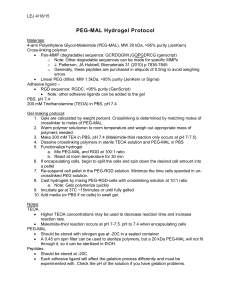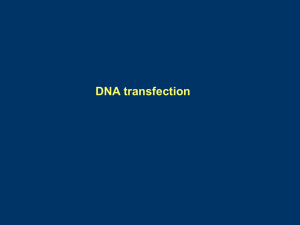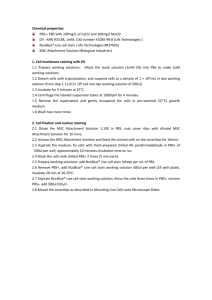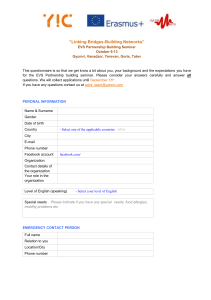Handling of C17 - Biofluidics Lab
advertisement
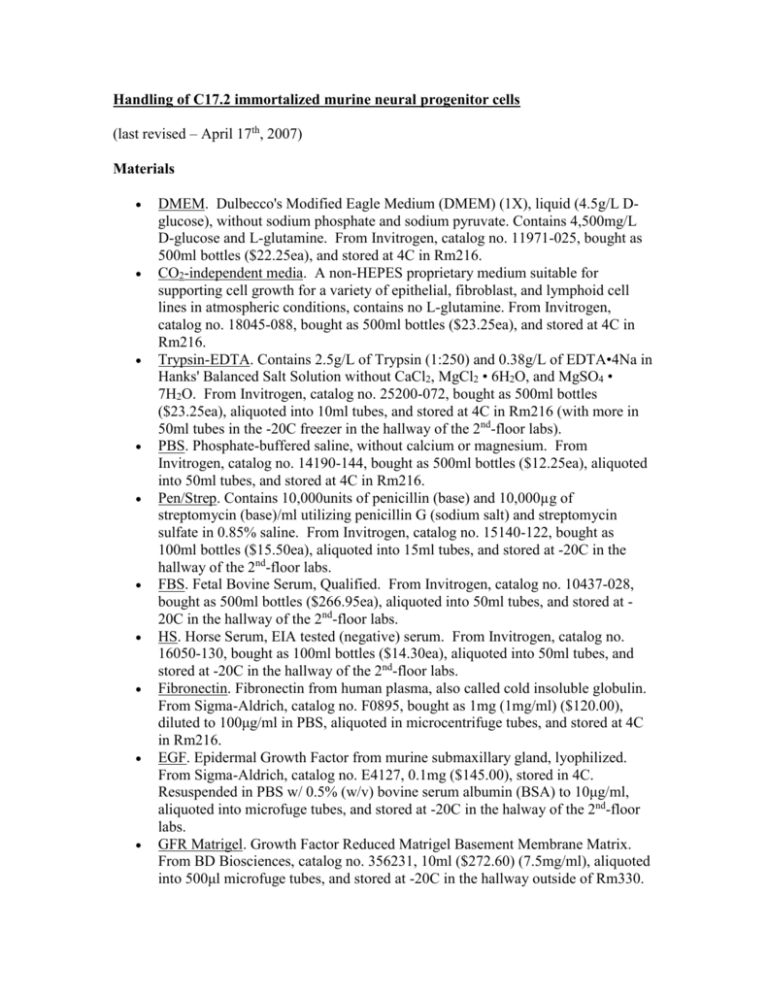
Handling of C17.2 immortalized murine neural progenitor cells (last revised – April 17th, 2007) Materials DMEM. Dulbecco's Modified Eagle Medium (DMEM) (1X), liquid (4.5g/L Dglucose), without sodium phosphate and sodium pyruvate. Contains 4,500mg/L D-glucose and L-glutamine. From Invitrogen, catalog no. 11971-025, bought as 500ml bottles ($22.25ea), and stored at 4C in Rm216. CO2-independent media. A non-HEPES proprietary medium suitable for supporting cell growth for a variety of epithelial, fibroblast, and lymphoid cell lines in atmospheric conditions, contains no L-glutamine. From Invitrogen, catalog no. 18045-088, bought as 500ml bottles ($23.25ea), and stored at 4C in Rm216. Trypsin-EDTA. Contains 2.5g/L of Trypsin (1:250) and 0.38g/L of EDTA•4Na in Hanks' Balanced Salt Solution without CaCl2, MgCl2 • 6H2O, and MgSO4 • 7H2O. From Invitrogen, catalog no. 25200-072, bought as 500ml bottles ($23.25ea), aliquoted into 10ml tubes, and stored at 4C in Rm216 (with more in 50ml tubes in the -20C freezer in the hallway of the 2nd-floor labs). PBS. Phosphate-buffered saline, without calcium or magnesium. From Invitrogen, catalog no. 14190-144, bought as 500ml bottles ($12.25ea), aliquoted into 50ml tubes, and stored at 4C in Rm216. Pen/Strep. Contains 10,000units of penicillin (base) and 10,000µg of streptomycin (base)/ml utilizing penicillin G (sodium salt) and streptomycin sulfate in 0.85% saline. From Invitrogen, catalog no. 15140-122, bought as 100ml bottles ($15.50ea), aliquoted into 15ml tubes, and stored at -20C in the hallway of the 2nd-floor labs. FBS. Fetal Bovine Serum, Qualified. From Invitrogen, catalog no. 10437-028, bought as 500ml bottles ($266.95ea), aliquoted into 50ml tubes, and stored at 20C in the hallway of the 2nd-floor labs. HS. Horse Serum, EIA tested (negative) serum. From Invitrogen, catalog no. 16050-130, bought as 100ml bottles ($14.30ea), aliquoted into 50ml tubes, and stored at -20C in the hallway of the 2nd-floor labs. Fibronectin. Fibronectin from human plasma, also called cold insoluble globulin. From Sigma-Aldrich, catalog no. F0895, bought as 1mg (1mg/ml) ($120.00), diluted to 100μg/ml in PBS, aliquoted in microcentrifuge tubes, and stored at 4C in Rm216. EGF. Epidermal Growth Factor from murine submaxillary gland, lyophilized. From Sigma-Aldrich, catalog no. E4127, 0.1mg ($145.00), stored in 4C. Resuspended in PBS w/ 0.5% (w/v) bovine serum albumin (BSA) to 10μg/ml, aliquoted into microfuge tubes, and stored at -20C in the halway of the 2nd-floor labs. GFR Matrigel. Growth Factor Reduced Matrigel Basement Membrane Matrix. From BD Biosciences, catalog no. 356231, 10ml ($272.60) (7.5mg/ml), aliquoted into 500μl microfuge tubes, and stored at -20C in the hallway outside of Rm330. Cell Culture Plates. Tissue culture-treated polystyrene. I prefer Falcon® 6-well plates, bought from Krackeler Scientific, catalog no. 3-353046, bought as boxes of 50 individually-sealed plates ($50.60). Kept in the hallway, by Rm330. These have a well diameter of 34.8mm, growth area of 9.6cm2/well, and a working volume of about 3ml/well. All volumes for growth media, PBS washes, trypsin, etc., are in reference to a well of cells in these plates. For scaling to other cell culture vessels, the critical issue is surface area. A comprehensive brochure for understanding cell culture can be found in this PDF; briefly however, 12well plates (3.8cm2), 24well plates (2.0cm2), 96well plates(0.32 cm2), 100mm dishes (55cm2), 60mm dishes (21cm2), 25cm2 flasks, and 75cm2 flasks are also available. Media (all aliquoted in 50ml tubes, and stored at 4C in Rm216): Growth Media. DMEM, supplemented with 10% fetal bovine serum, 5% horse serum, and 1% pen/strep. Starvation Media. DMEM, supplemented with 1% pen/strep. Weather Station Media. CO2-independent media, supplemented with 1% pen/strep. Definitions: Aspirate: to remove media with a Pasteur pipet, with suction provided by a vacuum pump. Confluency: Cell density of monolayer-cultured cells, reflecting the percentage of surface area covered by the cultured cells. Passaging C17.2 Cells: Things to keep in mind: Passage cells at approx. 5000 cells/cm2, or 50,000 cells per well in 6well plates.. They double approximately every 24 hours, and should be passed every other day. Do not let cells grow to a density of greater than ~30,000cells/cm2. The media contains phenol red, which is an indicator of pH levels. At a pH level of about 7.4, which is desired, it should be a light peach color; as pH drops, it will turn darker and more red. Possible reasons why it could become acidic include loss of CO2 partial pressure, throwing off the balance of the bicarbonate buffer in DMEM, or metabolic consumption of the nutrients in the media (after the cells eat all their “food”). C17.2 cells, like other adherent cells of mesenchymal origin, begin attaching to polystyrene in as little as 20min, and are spread in as little as 60min. Over-expressed EGFR appears to slow this attachment and spreading, while slightly increasing the rate of proliferation. Procedure: 1. Aspirate off media, briefly wash twice with 1ml PBS, aspirating that off as well after each wash. 2. Add 200µl trypsin-EDTA. Place cells in the incubator for a couple minutes. 3. Smack side of plate to dislodge remaining cells, and add (1ml) Growth Media to neutralize the trypsin-EDTA. 4. Pipet 20μl into hemacytometer, and count cells. The number of cells in the tripleruled region represent the cell concentration per 0.1μl. 5. Calculate the correct volume of suspended cells to transfer 50,000 cells to a new culture well. 6. Seed this volume of cells into the new cell culture plate, add Growth Media to a total volume of 3ml, and place into the incubator. Starving C17.2 Cells: Procedure: 1. One day after passaging cells (see above), aspirate media off, and wash once with 1ml PBS. 2. Add 3ml Starvation Media, and return cells to incubator. 3. Use cells for experiment ~24hours later. Alternatively, you will sometimes need to work with cells under normal atmospheric conditions (i.e. without an incubator supplied with CO2). In this case, use CO2-independent media. Always wash cells with PBS when switching media. Preparing Cells for Microfluidic Devices: Procedure 1. Plan ahead: if you want a cell density higher than 1 million cells/ml to add to the microfluidic device, you will want to use all 6 wells of a 6well plate, with cells grown to ~80% confluency. 2. Aspirate off media, briefly wash twice with 1ml PBS, aspirating that off as well after each wash. 3. Add 200µl trypsin-EDTA. Place cells in the incubator for a couple minutes. 4. Smack side of plate to dislodge remaining cells, and add (1ml) CO2-independent media to neutralize the trypsin-EDTA. 5. Transfer cells to a 15ml Falcon® tube, and combine the suspended cells from multiple wells, to maximize the final density of suspended cells. Add CO2independent media to bring the volume to 5ml total, and centrifuge at 1000rpm for 5min. 6. Aspirate off supernatant, and resuspend cells in 200µl CO2-independent media. 7. Count cells in hemacytometer, as though you were passaging the cells, and dilute as desired. Cells are ready to place into device. Surface Adsorption of Extracellular Matrix (ECM) Proteins: (e.g. fibronectin, collagen, matrigel, poly-lysine, etc.) Procedure: 1. Keeping stock ECM solution chilled, dilute a sample to Xμg/ml, with PBS. 2. Cover desired surface with enough ECM mixture to create about 1mm depth of liquid. 3. ECM proteins will adsorb onto a surface on its own, given enough time. Temperature influences this, such that room temperature for one hour is sufficient, or overnight in the refrigerator (4C). 4. Replace PBS with media, cells, etc., and use in experiment. Cryopreservation of Neural Stem Cells Freezing Procedure: 1. Culture all 6 wells on a plate to about 80% confluency before preserving them. Generally, it is recommended to freeze cells such that 1 well equals 1 cryovial, so you should also appropriately label 6 cryovials ahead of time. 2. Aspirate off media, briefly wash each well twice with 1ml PBS, aspirating that off as well after each wash. 3. Add 200µl trypsin-EDTA to each well. Place cells in the incubator for a couple minutes. 4. Smack side of plate to dislodge remaining cells, and add (1ml) Growth Media to neutralize the trypsin-EDTA. 5. Transfer 6 wells of cells to a 15ml Falcon® tube, and centrifuge them for 5min at 1000 rpm. 6. Remove the supernatant, and resuspend the cells in 6ml of a 90/10 mixture (90% Growth Media + 10% DMSO), without introducing air bubbles, and aliquot 1ml per cryovial. Then, transfer to an “isopropanol chamber” to control the rate of gradual freezing, and place in -80C freezer. This step should be done as quickly as possible, to minimize exposure of the cells to DMSO (preferably this step should be done in about 1minute. 7. The next morning, transfer to liquid nitrogen tank for long-term storage. C17.2 cells from the Wu Group are currently stored in box 6 of stack 2 in the large liquid nitrogen tank in Duffield Hall Rm201. Alternative Freezing Procedure (using a 75cm2 culture flask): 1. Grow cells to ~80% confluency in 75cm2 cell culture flask – this will provide enough cells for up to 10 cryovials. Label cryovials ahead of time. 2. Aspirate off media, briefly wash each well twice with 5ml PBS, aspirating that off as well after each wash. 3. Add 1ml trypsin-EDTA to each well. Place cells in the incubator for a couple minutes. 4. Smack side of plate to dislodge remaining cells, and add (4ml) Growth Media to neutralize the trypsin-EDTA. 5. Transfer the cell suspension to a 15ml Falcon® tube, and centrifuge it for 5min at 1000 rpm. 6. Remove the supernatant, and resuspend the cells in 10ml of a 90/10 mixture (90% Growth Media + 10% DMSO), without introducing air bubbles, and aliquot 1ml per cryovial. Then, transfer to an “isopropanol chamber” to control the rate of gradual freezing, and place in -80C freezer. This step should be done as quickly as possible, to minimize exposure of the cells to DMSO (preferably this step should be done in about 1minute. 7. The next morning, transfer to liquid nitrogen tank for long-term storage. C17.2 cells from the Wu Group are currently stored in box 6 of stack 2 in the large liquid nitrogen tank in Duffield Hall Rm201. Thawing Procedure: 1. Thaw one cryovial in 37C bath for 1min, and add with 4ml Growth Media into a 15ml Falcon® tube. 2. Avoid introducing bubbles, and minimize the thawed-time that the cells are exposed to the DMSO 3. Centrifuge cells for 5min at 1000rpm, and remove supernatant. 4. Reconstitute in 3ml Growth Media, and begin passaging as usual in a well of a 6well plate. Other Treatment Notes The standard usage concentration of Epidermal Growth Factor (EGF) is 10ng/ml, relating to physiological concentrations more, although 100ng/ml may be slightly better still. 5μg/ml ECM protein (e.g. fibronectin, collagen, matrigel, laminin, etc.) is considered optimal for cell motility measurements. Cells are more adherent (and less motile) at and above 10μg/ml, and not adherent enough below 1μg/ml.

